Anatomy of Facial Expression – book content

People notice fake emotions.
Creating genuine facial expressions requires knowledge that has to be learned.
The human face is not only a surface with eyes, mouth, and nose for reading the essential information about the world around us. The Anatomy of Facial Expression book highlights that it’s also our primary non-verbal communication tool, an instrument with the highest precision.
Humans are amazingly good at reading the slightest changes in other people’s faces. Historically, this has been crucial for creating social environments and saving our ancestors’ lives. Interestingly, even animals have learned to read our faces – dogs are a good example. But none of them do it as well as we humans do.
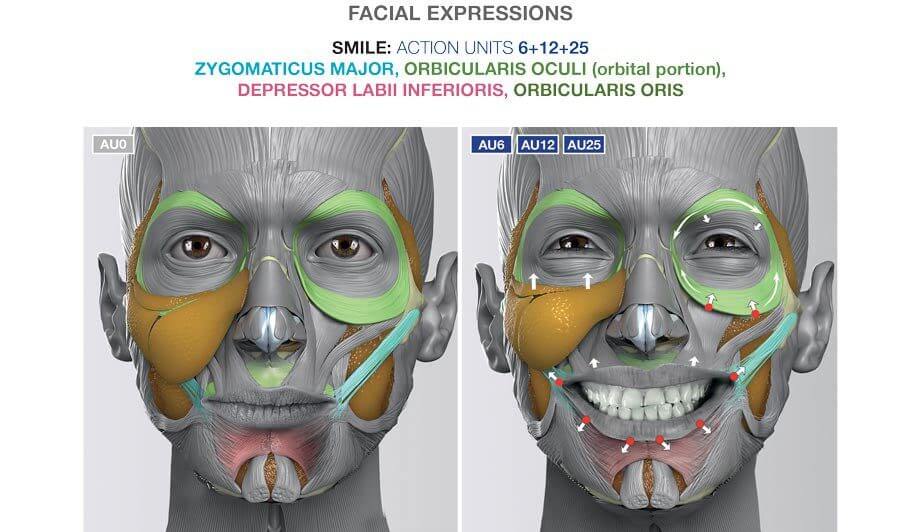
When we receive visual information, it first reaches the Thalamus, which immediately sends the data to all the necessary parts of the brain. The two that interest us most are the Visual cortex (area in the brain that creates visual images) and the Amygdala (which tests information for an element of danger). The latter can make us feel fear simultaneously while we are still creating a visual representation of what frightened us.
Body language and facial expressions evolved much earlier than verbal
language. Babies already have this skill as early as they can focus their vision on their parents’ faces. A baby can identify positive facial emotions earlier and more accurately than negative ones (Boyatzis, Chazan, & Ting, 1993; Camras & Allison, 1985; Widen & Russell, 2003). Their accuracy increases between 3 and 7 years of age. The ability to recognize emotional facial expressions is innate in us.
Some studies have provided convincing evidence that the facial expressions for basic emotions are universal. It means that the basic facial expressions are shared between all humans on the planet, whether you’re an Eskimo, European, or from a tribe in the Brazilian jungle. (Ekman & Friesen, 1971; Ekman et al., 1987; Ekman, Sorenson, & Friesen, 1969; Elfenbein & Ambady, 2002; Izard, 1971).
Our body knows what we see even before we see it
To characterize this phenomenon, let’s imagine a situation: “A husband bumps into his angry wife. The visual information from the wife’s angry face enters the husband’s eye; the eye sends a neural signal to the Thalamus.
The Thalamus sends neural information directly to the Amygdala and the
Visual cortex. It means the husband knows he’s in trouble even before his brain has had time to generate a visual image of the angry spouse. He gets an adrenaline release in the blood.”
In situations like this, our consciousness might not yet be aware of what happened. But we already have some feelings as evidence: “Hey, something is not right!” Even tiny details in the surrounding environment, especially in people’s faces, can significantly impact us. That’s why it’s so important to be precise when creating a human face; fortunately, all of that is covered in the Anatomy of Facial Expression book!
The most famous object of art at all times has been the human. It doesn’t
even have to be lifelike. It just needs to trigger our body to react as if it were real. Our eyes are continually scanning our surroundings, and a unique area in the brain called the Fusiform face area – FFA is analyzing if there are any human faces around. Sometimes it sees faces where there are no faces. This phenomenon is called Pareidolia. A famous example of Pareidolia is the Face on Mars.

After our “scanner” has identified a face with an element of danger, the next level of analysis is the quality of the emotion. We’ve all had to do fake-smiling at some point in our lives. As you’ll learn in the Anatomy of Facial Expression book, there’s almost no difference between a Genuine smile and a Fake smile. Yet, there is a slight change in the form of the face, and it has great significance in our perception – everyone immediately sees the difference.
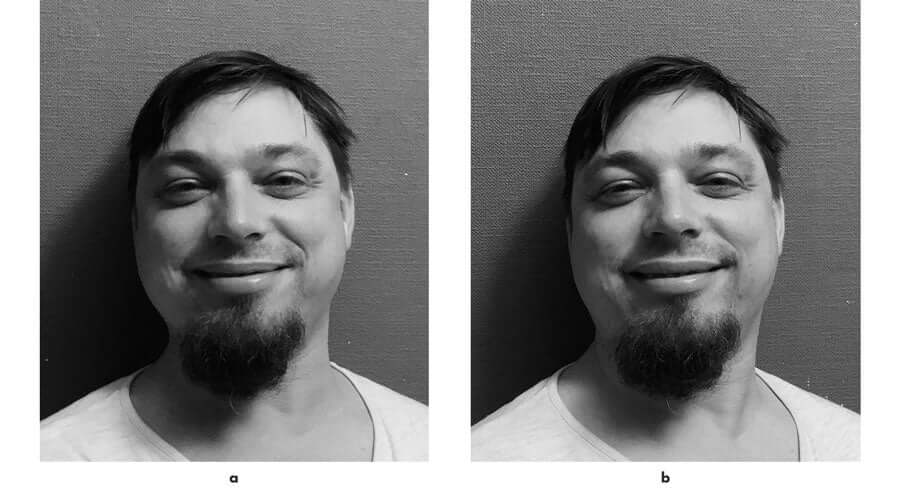
Even small details can make a huge difference
Real emotions are almost impossible to fake, and that is why the Anatomy of Facial Expression book teaches you to recognize the nuances that differentiate fake and genuine emotions.
You have to understand the anatomy which creates those nuances to do it. But in addition to that, you also have to have the right tools and the precise vocabulary to accurately describe the change in the face that happens between Genuine smiling and Fake smiling.
The best way to achieve this is to analyze each facial expression and track the changes in each element of the facial anatomy. In the Anatomy of Facial Expression book, we use Paul Ekman’s FACS (Facial Action Coding System) which breaks down each facial expression into action units to help you notice each change.
A picture is worth a thousand words
Is the knowledge about the facial movements found in the Anatomy of Facial Expression book unique? Facial physiology is indeed a well-described topic by authors such as Carl-Herman Hjortsjö or, more recently, Joseph C. Hager’s Update to FACS in 2002.
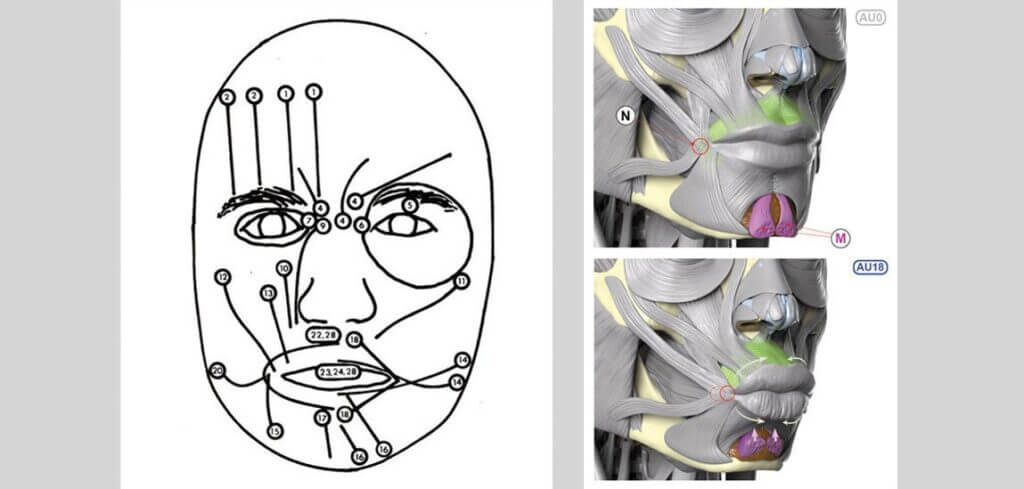
However, these works are missing excellent images, which the Anatomy of Facial Expression book has plenty of! In these other works, the most you could hope for when they describe some facial movement are lists of the names of the muscles, the codes of the action units, and maybe a black and white photograph, if you’re lucky.
The Anatomy of Facial Expression book introduces an entirely different approach: the primary source of information in the book is visual images. And excellent ones! Just notice the difference in the picture above – on the left is a depiction you would usually find in these materials, and on the right is the same topic visualized in the Anatomy of Facial Expression book.
The visual aspect matters the most for artists: images and understandable information design with only the most crucial factual information and Latin names of muscles. For an animator, the essential thing is how it works.
For artists, the essential part is how it looks
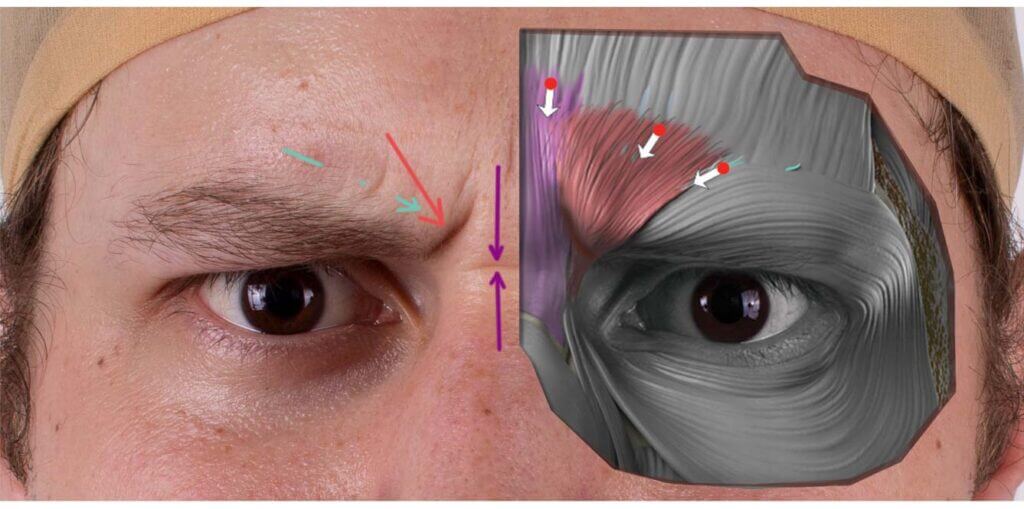
Do facial muscles create the form of the face?
When we think about face anatomy for artists, the first thing that comes to mind is facial muscles. Do facial muscles create the form of the face? The answer: “Yes and no!”
Elsewhere in the human body, the typical skeletal muscles usually influence the form of the human body with their own shapes. In the Anatomy of Facial Expression book, you’ll discover that these kinds of muscles are mostly absent from the human face.
An exception is the mastication muscles – like the Masseter and Temporal muscles – that have a distinct form. In the face, we mostly have facial mimicry muscles, which are very thin and almost formless. The Anatomy of Facial Expression book explains how they move the surface forms, mostly made up of fat compartments.
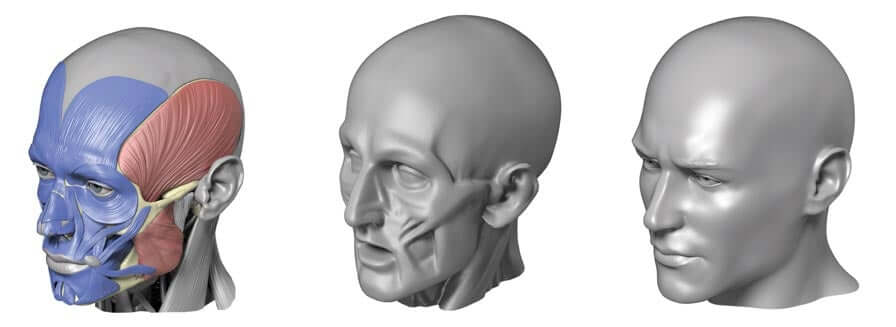

What about different genders and ages?
The fact that we understand the anatomy of the face and how the facial muscles work is not enough. You need to understand the surface shapes as well. The forms are mostly made up of bones and soft tissue. But are we all the same? No, of course not. In addition to the individual morphology, which is infinitely diverse, there are formal features for different ages and genders.
The Anatomy of Facial Expression book touches on these subjects, such as ethnicity. But there is far more detailed information available: explore the additional topics in the most recent book – Form of the Head and Neck.
Gender:
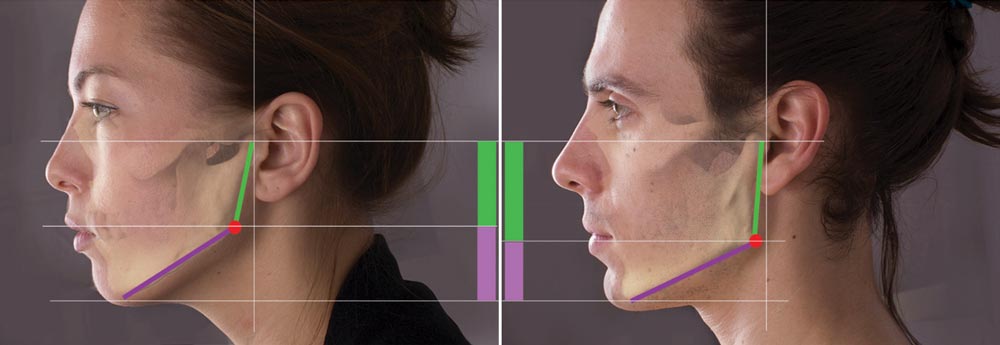
Age:
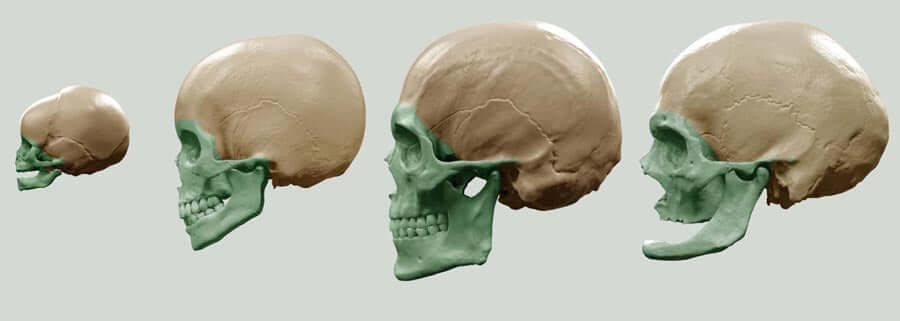
Interested in the Anatomy of Facial Expression book?
The Anatomy of Facial Expression book, compared to the Understanding the Human Figure book, which describes the methods of creating an entire human figure, dives much deeper, specifically into the topic of facial anatomy and facial expressions. The task of the Anatomy of Facial Expression book is to help artists create specific facial expressions and understand the anatomy behind them. This book is specially created with artists in mind – it’s 222 pages of pure visual content, with only about 5% of the book being text.
Anatomy of Facial Expression book on Kickstarter
See how the project for the Anatomy of Facial Expression book went: the project page is here. See our original campaign video, text, and images that we created for this Kickstarter. We thank our community immensely for all the support that we received – it’s also all visible on this page! The Anatomy of Facial Expression book would have been impossible without your feedback and help. Follow us on Anatomy for Sculptors Kickstarter page if you want to be the first to receive the news about any upcoming books.
Join our newsletter
Be the first to receive news about upcoming books, projects, events and discounts!

